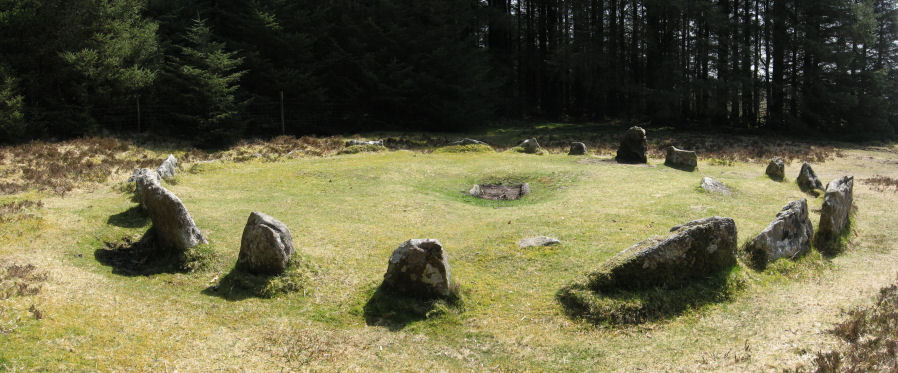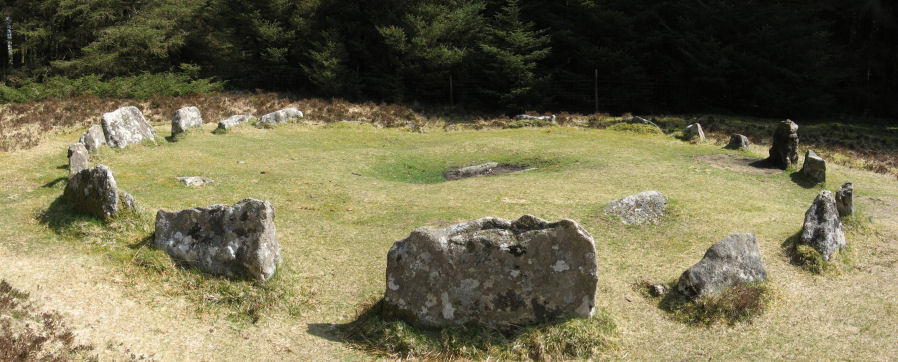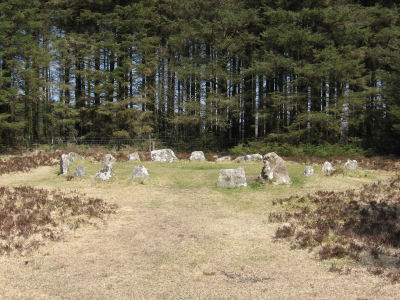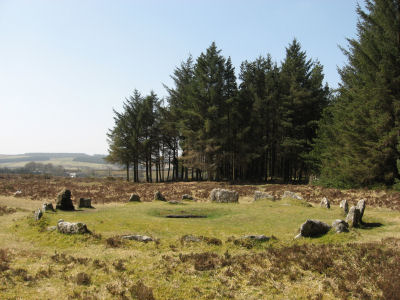
Soussons Cairn Circle
This site is featured on the Postbridge: Soussons Circle, Cator Pound, Challacombe walk. These photos are of Soussons Cairn Circle (SX67517869 Butler Vol. 2. Map 24, 2). In a clearing left by the Forestry Commission in the Soussons plantation is the Soussons Cairn Circle. It consists of 22 stones in a circle of diameter 8.6m with a central cist of two slabs. Curiously when this site was excavated by the Barrow Committee in 1903 they discovered human hair. They concluded this could not possible have been prehistoric as human hair should not survive in the acid soil for any length of time, the interesting Barrow report is reproduced below. When the site was visited by the author it looked like it had been damaged in recent years by the idiotic use of this prehistoric cist for camp fires!
About 1km north of this site are the Red Barrows (SX67677998), a group of 4 barrows in another clearing. There was also apparently a triple stone row near by which was destroyed by the planting of trees as well as being robbed in 1897 when the enclosure wall was constructed. For more on the Red Barrows and the stone row see the ninth report of the Dartmoor Exploration Committee reproduced below.
The photos below were taken on the 18th April 2010.
Bibliography & references
Baring-Gould, S. Ninth Report of the Dartmoor Exploration Committee in Report & Transactions of the Devonshire Association Vol. 35
Burnard, Robert. Twenty-Second Report of the Barrow Committee in Report & Transactions of the Devonshire Association Vol. 35
Butler, J. Dartmoor Atlas of Antiquities: Vol. 2. - The North (Devon Books, 1991)
External Links
Extract from Twenty-Second Report of the Barrow Committee
Source: Report & Transactions of the Devonshire Association Vol. 35 (1903) (spelling and punctuation is from the original article).
Soussons Common, Postbridge.
On Soussons (Southsands) Common, near Postbridge, is a sepulchral circle 28 feet in diameter. The stones composing this are 22 in number - not large stones - the tallest is about 2 feet above ground-level. On digging in the centre a fine kistvaen was uncovered. The cover stone was gone, but side stones of thin, shapely slabs remain. The north end of the kist was built up of small stones, and the south end was formed of a stone which did not reach the floor of the kist by some 10 inches. It, however, acted as a blocking stone and "spreader" to the side stones.
The whole of the kist was filled with "meat" earth. On removing this a layer of flat stones presented itself, and it was at first thought that the bottom of the kist was paved. These stones were 18 inches below the level of the side stones.
They were removed, and the true bottom of the kist was revealed. In the north end of the kist was a cavity, and in this were two large coils of human hair.
An account of this find, together with some of the hair, was sent to Mr. F.T. Elworthy. The latter had no doubt about the human origin of the hair, and this has since been confirmed by microscopical examination. Mr. Elworthy wrote as follows:-
"I think there is no sort of doubt that the deposit was made in comparatively modern times relatively to the kistvaen by some-one who knew of the latter and desired to work a spell on the former possessor of the hair. I have referred to the belief that sympathetic magic can be worked by the possession of any article (especially hair) that belonged to a person to whom it is desired to work evil (in my book The Evil Eye, p. 71, also p. 416).
"Since writing that I have much more evidence. In Italy it is a well-known rule to avoid leaving in any place any particle of hair, because if it falls under a witch's eye a curse is sure to follow you. The intention in your deposit was that as the hair was buried and pressed down under flat stones, so the owner of that hair might be caused to pine away and die. You have lighted on a true witch's piece of work which had no sort of connection with the prehistoric interment."
This interesting find may throw some light on the report made to Mrs. Bray that human hair had previously been found in Dartmoor kistvaens. (R. Burnard)
Ninth Report of the Dartmoor Exploration Committee
Source: Report & Transactions of the Devonshire Association Vol. 35 (1903) (spelling and punctuation is from the original article).
EXPLORATION OF RED BARROWS, SOUSSONS COMMON.
There are four barrows, or cairns, situated on the high ground of Soussons (or Southsands) Common, near Postbridge.
They were examined by the Committee in August of last year, mainly with funds kindly provided by the Teign Naturalists' Field Club.
The tumuli are four in number and lie close together in a line north and south. They are numbered from south to north. Numbers 1 and 2 are formed of earth; 3 and 4 are cairns of stone.
No. 1 has a diameter of 60 feet.
No. 2 has a diameter of 45 feet.
No. 3 has a diameter of 60 feet.
No. 4 has a diameter of 26 feet.
The earthen barrows are honeycombed with rabbit-holes, and the cairns have been so robbed of their stones that only the stumps of these erections remain.
As there was a depression in the centre of No. 1 indicating a previous examination, an excavation was made ten feet square at this point, and at a depth of six feet a pit sunk in the "calm," or subsoil, was found, which measured four feet by three feet and had a depth of twenty inches.
This pit contained some charcoal and a small flint flake. There was no doubt that this portion of the barrow had been previously examined, for the soil was loose all over the area of the excavation.
From this central excavation trenches were driven north, south, east, and west, in search of further interments, and this resulted in the discovery of a rudely built kistvaen at a distance of ten feet from the northern circumference. This small kistvaen was circular, two feet in diameter, and was roughly put together with small flat stones.
It contained burnt bones, including a small piece of a human skull and a flint flake.
Near the south circumference a small sherd of pottery was found of the Bronze Age type.
At this point the ground slopes, and here the barrow was strengthened by a revetment of large stones. These were covered by the soil of the barrow and were only revealed after digging.
Many hundreds of cartloads of earth were shifted during the exploration, and as nothing short of the removal of the entire barrow would satisfy a complete examination, further work was abandoned in favour of No. 2, which did not present so much evidence of previous disturbance.
Trenches were carried through this barrow (No. 2) east to west and north to south, with an additional trench north-west. All these trenches were enlarged in the centre, so that the total excavations represented a removal of about one half of the contents of the barrow. There were signs that the barrow had been previously dug into, but apparently the previous explorers had never reached the central pit in the "calm," for its contents were quite undisturbed. This contained wood charcoal and small fragments of burnt bone.
Adjoining the pit was an area paved with flat stones - under and between these wood charcoal and burnt bones.
This area of paved stones was four feet under central surface of the barrow and on a level with the lip of central pit.
Two and four feet above this paved area two fragments of bronze were found, but as this part of the barrow is full of rabbit-holes it is impossible to say whether this is their original location. They are fragments only and convey no idea of their original form.
A flint arrow-head was found nine feet from the western circumference and three feet under the sloping surface of the barrow.
The area of paved stones is very similar to that found in a barrow in the parish of Halwill (see vol. xxviii. p. 87).
It may have been a platform used for cremation purposes. Both Nos. 3 and 4 cairns were barren of any result; they were mere heaps of stone only a few inches above ground-level.
Three hundred yards north of the Ked Barrows is another ruined cairn, thirty-one feet in diameter, which stands at the head of a ruined triple stone row. This also was examined, but without success.
Soussons Cairn Circle





Page last updated 6/8/11